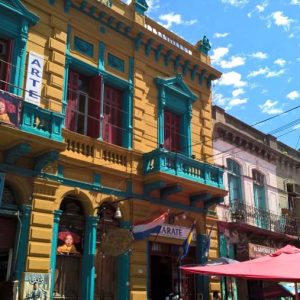On the Twentieth Anniversary of the American Queen Steamboat’s christening, I take a journey on the Mississippi River deep into the South and a by-gone era.
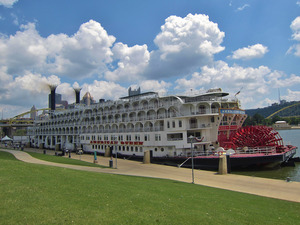 On approaching the riverside of New Orleans, I spot the brightly painted red and white American Queen decorated in U.S. flag designed bunting. The big red paddle wheel will soon start turning, churning up the silt filled water of the Mississippi River. I have just stayed overnight at the historic Hotel Bourbon Orleans in the vibrant French Quarters. Built in 1881, it was formerly a convent for the Sisters of the Holy Family, an all-black order. A fascinating tale of a mixed race girl rebelling against the tradition of the day to become a placée, instead becoming a nun.
On approaching the riverside of New Orleans, I spot the brightly painted red and white American Queen decorated in U.S. flag designed bunting. The big red paddle wheel will soon start turning, churning up the silt filled water of the Mississippi River. I have just stayed overnight at the historic Hotel Bourbon Orleans in the vibrant French Quarters. Built in 1881, it was formerly a convent for the Sisters of the Holy Family, an all-black order. A fascinating tale of a mixed race girl rebelling against the tradition of the day to become a placée, instead becoming a nun.
On the river
I am now continuing my historic odyssey but on this amazing waterway – the third longest in the world. In honour of the twentieth anniversary of the American Queen’s christening, many festivities are planned for this special voyage including performances by the acclaimed Mark Twain interpreter, 77 year old Lewis Hankins. It will take seven nights to complete our journey up to Memphis. We will cover 682 miles and delve into the psyche of the Deep South.
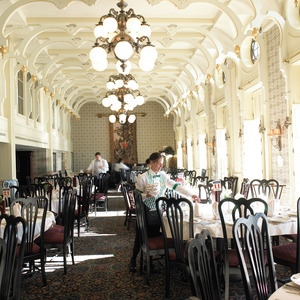 But first I acclimatise to my surroundings. I quickly find the Engine Room Bar and quench my thirst with a cool cocktail. Several folks are watching the Belmont Stakes (American equivalent of the Grand National) and enjoying popcorn from a serve yourself machine. I move into the next section of this deck to discover the Grand Saloon. This multipurpose venue has elegant velvet curtains surrounding its proscenium arch, all trimmed with fringe in a delightful aqua shade. The gold decorated royal boxes are draped with red velvet curtains and the 400 seat venue will soon feature the Steamboat Synchopators playing their nightly programme. Across the foyer is the J.M. White dining room which is almost an exact replica of a steamboat dining room of the 1800s including gas lamp styled chandeliers with huge round bulbs. Every night excellent Southern style cuisine is served during two separate seatings to hungry passengers.
But first I acclimatise to my surroundings. I quickly find the Engine Room Bar and quench my thirst with a cool cocktail. Several folks are watching the Belmont Stakes (American equivalent of the Grand National) and enjoying popcorn from a serve yourself machine. I move into the next section of this deck to discover the Grand Saloon. This multipurpose venue has elegant velvet curtains surrounding its proscenium arch, all trimmed with fringe in a delightful aqua shade. The gold decorated royal boxes are draped with red velvet curtains and the 400 seat venue will soon feature the Steamboat Synchopators playing their nightly programme. Across the foyer is the J.M. White dining room which is almost an exact replica of a steamboat dining room of the 1800s including gas lamp styled chandeliers with huge round bulbs. Every night excellent Southern style cuisine is served during two separate seatings to hungry passengers.
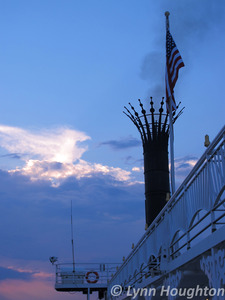 The 418 ft. long steamboat is the largest ever built and its two black funnels, both with fluted funnels (for dispersing cinder and chunks of wood in the early days) are 97 ft. tall. The American Queen is full of historic features, truly a restoration marvel: the Mark Twain tiffany lamp filled Gallery with a real silver Mississippi River water urn, a 1906 St Louis World’s Fair Budweiser Chandelier and more taxidermy than you can shake a stick at. The pilot and chart rooms appear much as they would have in the 19th century while the 222 staterooms each have mahogany doors. On the observation deck is a 37 pipe calliope which could wake the dead it is so boisterous and loud.
The 418 ft. long steamboat is the largest ever built and its two black funnels, both with fluted funnels (for dispersing cinder and chunks of wood in the early days) are 97 ft. tall. The American Queen is full of historic features, truly a restoration marvel: the Mark Twain tiffany lamp filled Gallery with a real silver Mississippi River water urn, a 1906 St Louis World’s Fair Budweiser Chandelier and more taxidermy than you can shake a stick at. The pilot and chart rooms appear much as they would have in the 19th century while the 222 staterooms each have mahogany doors. On the observation deck is a 37 pipe calliope which could wake the dead it is so boisterous and loud.
My stateroom has all the mod cons: air conditioning, hair dryer, TV, shower and bath but the décor is distinctly Victorian. Dark wood antiques, chintz curtains with floral design and fringe pull cords on lamps leave no doubt as to the period this is emulating.
The Mississippi
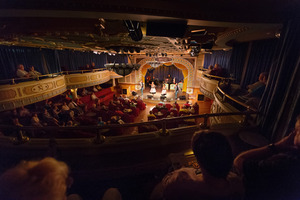 Since Mark Twain’s time, the Mississippi has changed markedly, getting straighter and losing about 400 miles of its very windy 2,600 mile length. The first steamboats appeared in 1812 and started steaming up and down the river from New Orleans to Memphis then St. Louis and beyond. The American Queen’s red paddle wheels churn up the brown silt filled water much as the vessel that she has been modelled on would have done 200 years ago.
Since Mark Twain’s time, the Mississippi has changed markedly, getting straighter and losing about 400 miles of its very windy 2,600 mile length. The first steamboats appeared in 1812 and started steaming up and down the river from New Orleans to Memphis then St. Louis and beyond. The American Queen’s red paddle wheels churn up the brown silt filled water much as the vessel that she has been modelled on would have done 200 years ago.
In the lower part of the Mississippi is delta country and flat as a pancake. There are a great many refineries and logging concerns along the banks. But after about a day and a half we pass the point on the river which marks where coastal traffic is no longer allowed. The landscape then changes to an endless green topography with trees coming right up to the banks of the river.
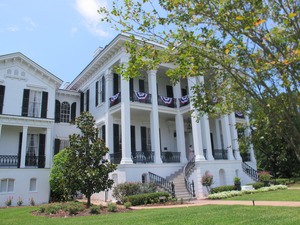 Our first stop is Nottoway Plantation near Baton Rouge. The free Hop On, Hop Off bus service, provided by the cruise line, takes me to the largest antebellum mansion in Louisiana. Built by John Hampden Randolph, it was finished just before the start of the Civil War. Today there is an historical society in attendance, dressed in traditional ball gowns and breeches, they perform a quadrille in the all-white ballroom. Tour guide Carole Ann, also dressed in 19th century finery, is an expert on the house and takes us on an abbreviated tour telling many stories of the Randolph family. On the same day there is a paid tour (Premium excursion) through the swamps and bayous which a must do if you haven’t already experienced the back waters of Louisiana. But at 90F and with high humidity, that swamp is going to be steamy today.
Our first stop is Nottoway Plantation near Baton Rouge. The free Hop On, Hop Off bus service, provided by the cruise line, takes me to the largest antebellum mansion in Louisiana. Built by John Hampden Randolph, it was finished just before the start of the Civil War. Today there is an historical society in attendance, dressed in traditional ball gowns and breeches, they perform a quadrille in the all-white ballroom. Tour guide Carole Ann, also dressed in 19th century finery, is an expert on the house and takes us on an abbreviated tour telling many stories of the Randolph family. On the same day there is a paid tour (Premium excursion) through the swamps and bayous which a must do if you haven’t already experienced the back waters of Louisiana. But at 90F and with high humidity, that swamp is going to be steamy today.
Further on up this vast waterway, our vessel veers off into the Yazoo River for a stop at Vicksburg, Mississippi. The site of the most important Civil War battlefield and siege in the country, it is certainly worth touring the 16 miles of road through the National Park for its memorials and cemeteries. The metal gunboat, USS Cairo, sunk during skirmishes at that time has now been resurrected and is on display. There are re-enactors that engage with guests to give a feel for what it would have been like to be one of the confederate soldiers during that time.
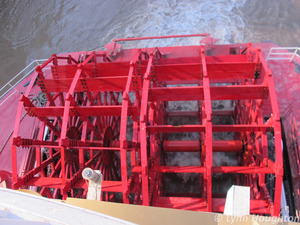 The first steamboats appeared on the Mississippi in 1812 and started moving goods, passengers and dreams up and down from the Minnesota headwaters to the Gulf of Mexico. This was well before the railroad had become the transportation of choice for the U.S.
The first steamboats appeared on the Mississippi in 1812 and started moving goods, passengers and dreams up and down from the Minnesota headwaters to the Gulf of Mexico. This was well before the railroad had become the transportation of choice for the U.S.
The heyday of the steamboat had a remarkable influence on the delta and the towns and cities along the river. Since the American Queen’s itineraries move to the upper Mississippi River and into the Ohio River during the hottest months of the year, a trip on this steamboat can be enjoyed all year round.
Redemption and Rehabilitation
A unique excursion organised by the American Queen is to Angola Prison, the Louisiana State Penitentiary. The largest, and once one of the most violent prisons in the U.S., it has been largely turned around by the reforms and efforts of Warden Burl Kane, a former educator. The 18,000 acre agricultural institution has over 6,300 inmates all of which must work in some capacity. There are no exceptions. And there is no gang behaviour here. Most of the prisoners are serving life sentences and 83 are on death row. The prison is self-supporting due to its extensive sugar cane crops and it also grows all types of vegetables for onsite consumption. There is a yearly rodeo show in an 11,000 seat venue with concession stands run by the inmates which brings in an enormous profit.
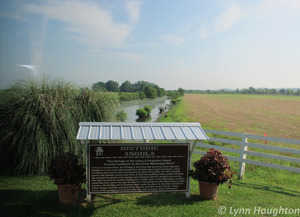 Samuel James bought the original acreage of 8,000 acres after the Civil War in 1865. He then ‘leased’ inmates from the state of Louisiana to work the plantation and build roads and levees and created the Angola Prison. This was legalised slavery with a particularly brutal system of discipline and sub-standard living conditions. The James Lease system was eradicated in the early 1900s.
Samuel James bought the original acreage of 8,000 acres after the Civil War in 1865. He then ‘leased’ inmates from the state of Louisiana to work the plantation and build roads and levees and created the Angola Prison. This was legalised slavery with a particularly brutal system of discipline and sub-standard living conditions. The James Lease system was eradicated in the early 1900s.
The prison’s most famous inmate was Charles Frasier. A violent and frequent offender, he had escaped from prisons in Texas and was ultimately sent to Angola and placed in the Red Hat cell block – named for the red dyed straw hats worn by the most incorrigible prisoners. Charles made a bold escape attempt from Angola but was captured and, ultimately, ended his life here. When on his death bed as an old man, he gave a phone number to be called after he was deceased. It was President Lyndon B. Johnson’s office. Eldon Johnson (Charles Frasier was his alias) was the President’s Uncle.
More information
Lynn took an 8-night trip on the wonderful American Queen. Information about New Orleans at neworleanscvb.com.


